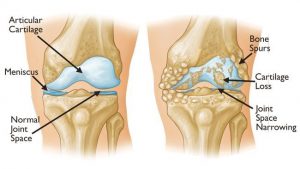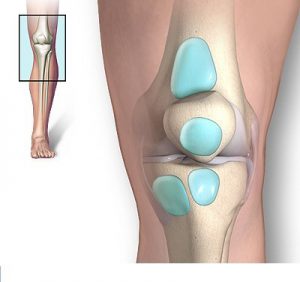Zeljko Kojadinovic, MD- Neurosurgeon and Pain Specialist
Knee pain can be the result of injury, inflammation, degenerative changes, and more
In the case of knee trauma, there may be injured bones (femur and the bone of the lower leg) or soft tissues. Soft tissues that are most frequently injured are the outer and inner ligaments of the knee, as well as the menisci. Diagnostic protocol implies examination, X-ray (bone), knee recording ultrasound, MRI, and endoscopy (arthroscopy). During arthroscopy, therapeutic intervention can be performed immediately. However not all sources of knee pain can be treated by arthroscopy.
Degenerative changes (gonarthrosis) lead to the damages of knee cartilage. They are associated with increased knee load (knee instability, knee muscle weakness, excess weight, sports activities, frequent injuries, metabolic disorders, etc.). In addition to this, the hereditary factor is very important.
The degree of damage is determined by X-ray, and most precisely by ultrasound or MR imaging of the knee.
Treatment includes physical treatment and strengthening of the knee muscles, analgesics in case of a painful phase, application of drugs to the knee, strengthening of the joint with external orthoses, and, in the most severe cases, replacement of the knee with an artificial one. Injecting stem cells and growth factors (PRP) into the knee have produced good results, by helping regenerate cartilage and other tissues. Arthroscopy has not demonstrated a significant advantage over conservative treatment methods here.
Inflammatory processes can affect the knee (arthritis, gout) and surrounding structures such as bursae – various types of bursitis, inflammation of the patellar tendon, ligament attachment, muscle attachment, etc. These inflammatory processes are treated by using analgesics at an early stage, and by injecting drugs in the form of a suspension of crystals into the inflamed structure. These medications dissolve gradually over the course of weeks and calm down the inflammation.
There are also other processes that are manifested by knee pain, such as Becker’s cyst, patellar chondromalacia, transmitted pain from other structures (e.g., pressure on the peroneal nerve, disc herniation, tumors).


Once the cause of the knee pain has been determined precisely, specific treatment can be given. Unfortunately, the real cause of the pain is often not determined, so treatment is frequently unsuccessful. The following reasons are usually blamed for this: worn out cartilage, age of the patient, obesity, poor posture, mental state, other chronic diseases, rheumatism, etc.

